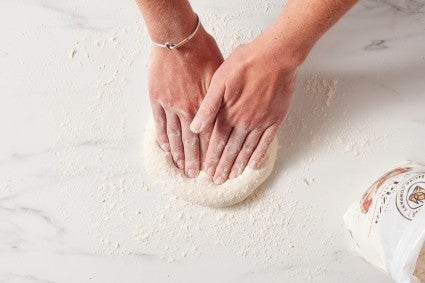Help! My pizza dough keeps shrinking back when I shape it.
How to stretch pizza dough — the right way.


 The bakers of King Arthur are here to solve the kitchen conundrums you share with us, whether it’s on the phone, computer, or by the good old postal service. In Ask the Baker’s Hotline, Annabelle will pick the brains of the talented King Arthur Baker’s Hotline team to tackle some of your most-asked questions. Today’s query: how to stretch pizza dough.
The bakers of King Arthur are here to solve the kitchen conundrums you share with us, whether it’s on the phone, computer, or by the good old postal service. In Ask the Baker’s Hotline, Annabelle will pick the brains of the talented King Arthur Baker’s Hotline team to tackle some of your most-asked questions. Today’s query: how to stretch pizza dough.
* * *
Are you tired of wrestling with pizza dough that just won't cooperate? Does the dough spring back no matter how many times you stretch and pull? Clara from our Baker’s Hotline has the tips and tricks to avoid this frustrating (and seemingly never-ending) cycle.
The culprits of this doughy push-and-pull are the tight and stubborn gluten strands within the dough. Actions like kneading, folding, and shaping all strengthen the gluten network, but sometimes they make it so strong that the dough becomes resistant to stretching. Which means that to stop shrinking, you’ve got to work with — not against — the gluten.
To save time and help with shaping, “you can divide and preshape your dough directly after kneading,” says Clara. The dough will undergo its first rise (bulk fermentation) while already shaped into rounds — allowing the dough to relax into a circular shape and rise simultaneously. “This is a great option for quick recipes,” Clara says, “and you can see this described in step 1 of our The Fastest Homemade Pizza Ever recipe.” (Which is made start-to-finish in just an hour!)
This technique is especially helpful when making pan pizzas, such as rectangular Loaded Baked Potato Pizza, as you can place the dough directly in the pan for its bulk ferment and allow it to rise in that same shape. (For rectangular or square pan pizzas, avoid preshaping the dough into a circle, as it will make it more difficult to stretch into shape later.)

If you start to stretch your pizza dough and it fights back, the simplest solution is to exercise patience. “Walk away and let the dough rest for 15 minutes, longer if necessary,” Clara says. This breather allows the tight gluten strands to relax and settle into their new shape, making them more accommodating when you return. Consider this a crucial step in achieving that perfect, easy-to-stretch pizza crust.
To ensure the dough doesn’t dry out while resting, cover it with an upside-down bowl, damp towel, or your reusable food wrap of choice.
How you stretch the dough matters, too. Dough will be more agreeable when pushed and pressed, rather than pulled. This is the method called for in most pan pizza recipes, and it can also be used to shape free-form round pies, as described in this video.

To really allow gluten to relax, you can refrigerate preshaped dough overnight, then stretch and shape the next day. This extended rest not only builds flavor but also ensures you have ready-to-shape dough balls in the fridge at a moment's notice. “This is my favorite technique when making our Neapolitan-Style Pizza recipe,” shares Clara. “Just do an overnight rest in the fridge in place of step 9!” Because of the long rest, the gluten will be relaxed and the dough should stretch easily.
An additional trick up your sleeve is our Easy Roll Dough Improver, a helpful ingredient that uses dry milk powder (among other ingredients) to prevent gluten strands from tightening up during the shaping process. Simply add 1 tablespoon for every cup of flour in your recipe, mixing it in with the rest of your dry ingredients. (As a bonus, you can use it for pie crust too!) The resulting dough will stretch without shrinking, making shaping much easier.
Mastering the art of pizza dough stretching is a blend of patience, strategic timing, and a few handy tricks. Which pizza recipe will you be testing your newfound skills with? Will it have thin crust or thick crust? Will you go for a no-knead artisan pie or one that uses your sourdough starter? The options are endless!
Cover photo by Rick Holbrook; food styling by Kaitlin Wayne.


